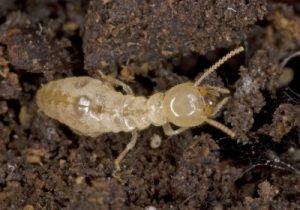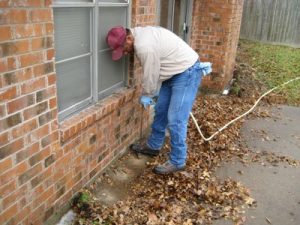
Eastern subterranean termites (Reticulitermes flavipes) are one of many species of termites that are known today.
These termites live in huge colonies of up to 1 million members and build their nest mainly under the ground surface.
Eastern subterranean termites are found in tropical and subtropical regions such as deserts and rain forests, as well as in the USA, Australia and Asia.
Hide content
- How Do Eastern Subterranean Termites Differ from Other Termites?
- Eastern Subterranean Termites Life-Cycle and Hierarchy
- Photo
- Eating Habits and Behavior
- Reproduction
- Signs of Subterranean Termites Infestation
- Eastern Subterranean Termites Treatment
- Non-Chemical Termite Control Methods
- Preventive Measures
- Useful articles
- Helpful video
- Conclusion
How Do Eastern Subterranean Termites Differ from Other Termites?
Soldiers. Their bodies are of creamy-white color; heads are slightly brownish. Soldiers have no wings and have large jaws.
Workers. They have creamy colored bodies with no wings. Their size is about ¼ inch or less in length.
Alates (eastern subterranean termite swarmers). The body is dark (brown or black), the size is approximately ¼ to ½ inch long with two pairs of wings.Eastern Subterranean Termites Life-Cycle and Hierarchy
Their life-cycle consists of 6 stages:
- Egg.
- Immature (nymphs).
- Soldiers, workers or developing winged forms.
- Alates (swarmers).
- Male and female with wings dropped.
- Kings, queens.
Eastern subterranean termites are a highly-organized eusocial insects that have well-established hierarchy within the colony.
The average nest is from 10,000 to 1 million species.
Eastern subterranean termite classification:
The king and the queen lives in separate chamber and are tended by the workers. They perform the reproductive function.
Immature (nymphs). As the nymphs become larger, they also begin to damage wood. Workers and soldiers take care of them until they mature.
Reproductive caste (swarmers, “alates”). The flying stage that can form a new separate colony. Some alates do not have wings and stay in the colony as the replacement in case the queen or the king dies.
Worker caste (the largest caste). Make the most damage to timber and wooden buildings. They perform all the work in the nest. They gather food, take care for young nymphs until they become mature.
Soldier caste. They are the defenders of the colony, their principal enemy – marauding ants.Photo
What do eastern subterranean termites look like, pictures below:
Eating Habits and Behavior
Eastern subterranean termite facts. They have well-established social system within their colony, with perfect engineering capabilities and acute survival instinct.
These termites obtain moisture from the decaying timber and soil and communicate with the help of pheromone signals.These termites eat wood. These termites are the cause of decomposition of old branches, trees, stumps. The nutrients of these old structures can go back into the soil to be used by new plants as fertilizer.
These termites have an important organism living in their stomach (Tricohonympha agilis), the fungi that help termites to digest timber. These fungi do not harm the termite, and the termite would die without it.
Reproduction
A new colony forms when a Queen lays the eggs. The first eggs will hatch into the worker caste. Later, when there are enough workers, the Queen lays the eggs that will hatch into the soldiers that will protect the nest in the future.
Later on, the Queen will lay the eggs that will hatch into the reproductives.
Some reproductives do not have wings and stay in the colony as the replacement in case the queen or the king dies.
Though, most of them will grow into alates. When alates are adult, they will leave the colony to mate and form a new colony.
In spring and in the summer one can see a huge colonies of flying “ants”. They are the mating alates.
Warning! This is a real danger sign that a large mature termite forms a nest near your house. Such a nest can contain hundreds of thousands subterranean termites within range of infesting the timber of your house.After the alates mated, they will break off their wings, burrow into the soil and start a new colony. The pair will become the King and the Queen of the new colony.
Signs of Subterranean Termites Infestation
There are various sure signs of infestation that could be find during the inspection of the given areas (advice: for eastern subterranean termite identification you need a good flashlight, screwdriver or pocketknife and coveralls.)
Termites frass (droppings). The frass is just like a saw dust and looks like a small brown hillock. The termite frass is not dangerous for people and animals, but, all the same, it can cause various allergic reactions.
The existence of termite droppings indicates that there is a sound termite activity in the surrounding area. If the frass are on the beds, the termites are active on the attic.
Droppings on window sills say about termite activity inside the wooden window frame. When you wind frass on the floor it can be a termite activity in the basement or behind the walls. Carefully inspect all the corners, underneath the wall bases.
Swarmers. They are called “flying ants” and are often attracted by the light sources. Most swarmers emerge during the day, most frequently on warm days after rain.
The presence of “flying ants” may indicate, that the colony nest is near your dwelling.
Also, it is possible to see swarmers on the soil surface in spring or in the summer immediately after the rain.
Damaged or hollow-sounding wood. Termites can destroy wood material from the inside, at the same time the wood external appearance stays as usual.
If wood sounds hollow when tapped, it may be because termites are eating the wood from the inside out. Also, damaged wood when opened looks layered and rotten with a great number of frass.
Eastern Subterranean Termites Treatment
Nowadays there are various means of Subterranean termite control, most of them are highly available and quite budget-friendly:
Termicides – very effective means of termite treatment. There are various types of termicide termite treatment:Subterranean Termite Treatment Drilling – the principal aim of such treatment is to put a chemical blanket between the termites in the soil and the structure above. In many cases, affected termites will die of dehydration.
Repellent Termiticides: pyrethroids – a type of chemical compound – are fast acting nerve poisons that are highly toxic to termites but have low toxicity to mammals.
Non-Repellent Termiticides or Soil Treatment – these chemicals are not repellant and termites cannot detect them inside the ground.
The other broad treatment category of termite treatment is baiting. Termite baits consist of paper, cardboard, or other palatable food, combined with a slow-acting substance lethal to termites.
Another effective way to get rid of troublesome termites is termite tent fumigation. Fumigation has the advantage of being able to treat every part of the building and its structure immediately.
Be careful! Tent fumigation can be performed only by a specialist. Do not try to do it yourself!
Recommendation: if you do find the evidence of subterranean termite infestation, it is highly advisable not to resort to the help of do-it-yourself elimination activities.
One should immediately contact the local expert on termites, because the consequences of such negligence could be irretrievable.
Here you can learn more information about effective treatment method called tenting (fumigation): dangers for termites, preparing for fumigation and cleaning after, how long does this procedure last?Non-Chemical Termite Control Methods
- Boric acid.
- Cardboard trap.
- Sun or freezing for affected furniture.
Preventive Measures
- Avoid moisture accumulation near the foundation. Divert water away with properly functioning downspouts, gutters and splash blocks.
- Reduce humidity in crawl spaces with proper ventilation.
- Remove piles of trash and dead trees stumps from the area – such objects can attract termites.
- Avoid direct wood-to-ground contact when building porches or decks.
- Siding, brick veneer or foam insulation should not extend below soil grade.
Useful articles
If you interested in more information of termites we recommend you to read the following articles:
- All types of termites. Are they harmful to humans? Can they bite you? And what is the difference between drywood and subterranean ones?
- What does swarmers of different species look like: drywood, subterranean, formosan?
- Signs of infestation outside and in the house: in walls or furniture.
- What does termite holes look like? What is droppings and is it toxic to humans? Do termites make noises?
- Posible termite damage, how does it look like? Examples of damage in walls and wood floors.
- All about flying termites: how do they look like, swarming season and what to do if there are swarmers in your house?
- How do they do nests and mounds? How to find it in your garden or inside the house?
Helpful video
Typical termite swarm that occurred inside a building in downtown:
https://www.youtube.com/watch?v=qn3pzGmDlN0
Conclusion
Though termites are the real menace for timber and even stone buildings, still there are ways to eliminate termites nest colony within your yard.
It is not recommended to fight these insects yourself – only the highly experienced expert in termite eradication can help you to get rid of termites effectively.







